3D Picture |
  
|
Calling the command:
Icon |
Ribbon |
|---|---|
|
3D Model > Advanced > Insert 3D Fragment > 3D Picture Assembly (3D) > Assembly > 3D Picture |
Keyboard |
Textual Menu |
<3I> |
Operation > 3D Picture |
Unlike fragments, a 3D picture is a hull of a three-dimensional object, without parametric properties and relations between the picture elements. 3D pictures are used for creating three-dimensional assembly structures.
3D pictures cannot be used as the references for creating other elements, since their faces cannot be selected. You cannot use 3D pictures in Boolean operations either. Their 2D projections cannot be created. The Exploded View command cannot be applied to 3D pictures.
You can insert into a T-FLEX CAD document the 3D picture files in the following graphic formats: *.grb (T-FLEX CAD files), *.wrl (VRML files), *.iv (Open Inventor files), *.x3d, *.tf3d, *.3ds, *.ply, *.obj, *.stl, *.dxf, *.dwg, *.3mf, *.glb, *.gltf, *.nwd.
To save a 3D picture is part of a T-FLEX CAD document, that already contains a 3D model, set the parameter Save 3D Picture on the Save tab of the document parameters dialog box.
To save a 3D picture in a separate file in the *.iv, *.wrl, *.3d, *.ply, *.obj, *.stl, *.3mf, *.glb, *.gltf formats, use the File > Export command.
It should be remembered that when storing a 3D picture inside a T-FLEX CAD file, the amount of space occupied on disk increases significantly. The size of the 3D picture, in turn, depends on the grid density set in the document parameters at the time of picture creation.
Upon calling the command, you get the access to the following actions:
|
<Q> |
Repeat existing 3D Picture |
|
<F> |
|
|
<S> |
Select or create source LCS |
|
<T> |
Select or create target LCS |
|
<O> |
Select file |
|
<R> |
Repeat previous 3D Picture |
|
<I> |
Multiple iterated insertion of 3D picture |
To insert a 3D picture into an assembly, you need to do the following steps:
1. Select a 3D picture.
The selection can be done in two ways:
•By applying a new 3D picture (the option ![]() );
);
•By selecting an already inserted 3D picture (the option ![]() );
);
•By selecting an already inserted 2D fragment for using its 3D model (the option ![]() ).
).
2. Select or create the 3D picture's source coordinate system (the option ![]() ).
).
3. Select or create the target coordinate system (the option ![]() ). Only existing coordinate systems in the current document can be used as the target coordinate system.
). Only existing coordinate systems in the current document can be used as the target coordinate system.
4. Define the 3D picture parameters (optional).
5. Finish inputting the 3D picture (![]() in the automenu or in the property window).
in the automenu or in the property window).
Files can be selected either from the T-FLEX CAD library or from any folder on the disk.
In the drop-down list of option ![]() you can choose one of the three sources for the 3D picture.
you can choose one of the three sources for the 3D picture.
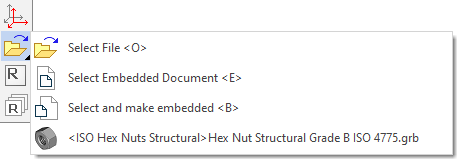
When you select option Select and make embedded, inserted 3D picture will be stored in the current document, not in an external file. Option Select Embedded Document appears only for files with embedded documents.
The name of the selected/internal document will be shown in the command's parameters window. Grey (not accessible for editing) field, located a little below is informational and shows the absolute path to the file from which the picture is taken.

If you click on the button to the right of the file path after selecting the file path, a drop-down list will appear:
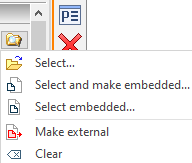
The first three options are the same as for option ![]() .
.
Option Make external allows uploading of the embedded picture to an external file. Option Clear allows quick removing of the pathname.
After adding 3D picture, you can change its position in space with special manipulator that appears in 3D window. By default, the origin of the manipulator is located in the center of the bounding box. If necessary, you can change the position of the manipulator by using option ![]() Select or create source coordinate system. Unlike the creation of 3D fragment, the original coordinate system of the 3D picture cannot be bound to the picture, because it has no geometric data. In the rest, the process of selection/creation of source and target coordinate systems is similar to the process of inserting 3D fragments. This process is described in the Transformations of 3D Elements section.
Select or create source coordinate system. Unlike the creation of 3D fragment, the original coordinate system of the 3D picture cannot be bound to the picture, because it has no geometric data. In the rest, the process of selection/creation of source and target coordinate systems is similar to the process of inserting 3D fragments. This process is described in the Transformations of 3D Elements section.
When creating a 3D picture, you cannot set the values of external variables. The 3D image is inserted with the values of the variables that are set in the 3D image drawing file at the time of its saving.
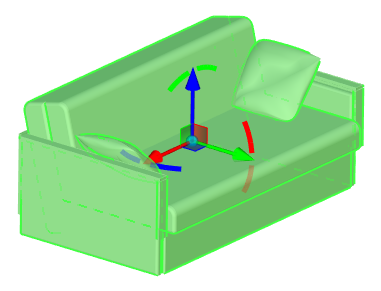
Transformations Tab
Transformations of 3D picture (translations and rotations) are displayed in the Transformations tab. Optionally section of the parameters window. Optionally, you can specify exact values for any transformation in the list.
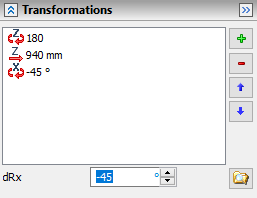
Scaling Tab
In the parameters window, you can specify the scale of 3D picture. The scale may be uniform along all axes or can be set separately for each axis. To specify a non-uniform scale it is necessary to remove the flag Uniform scale.
|
|
Options Tab
In Options tab you can set flag Create internal document. If the flag is active, the picture file is saved in the current document. This allows you to increase the speed of data loading. Otherwise, when you open a document, the system loads an external picture file.

You can apply coating material for 3D pictures. There are two ways to do it.
The first way is to apply the coating material to the 3D picture using “drag'n'drop” function. For this purpose, you need to open window Materials and to use the coating material from the list of model materials or from the Coatings library.
The second method is to choose the coating material in the parameters window of 3D picture. To do this, press option ![]() in automenu and choose the Common tab. Then, in the drop-down list of field Source select option From Document. After that, the field Material becomes available. In this field, you can select the coating material for 3D picture.
in automenu and choose the Common tab. Then, in the drop-down list of field Source select option From Document. After that, the field Material becomes available. In this field, you can select the coating material for 3D picture.
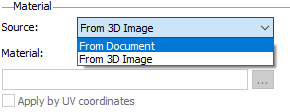
It is important that the coating material can be applied only for the entire 3D picture, because it represents a single object.
The option Apply by UV coordinates is available in the parameters of 3D Image. The option allows to apply material by UV coordinates that are stored in the 3D image file.

Additional Information
For the inserted 3D picture can be specified the units of measurement. After that, its size will be automatically recalculated. This function is useful for formats, which do not contain data about source measurement units of the picture. In this case, system will use measurement units specified in section 3D of Set Document Parameters command.
Topics in this section:
See Also: